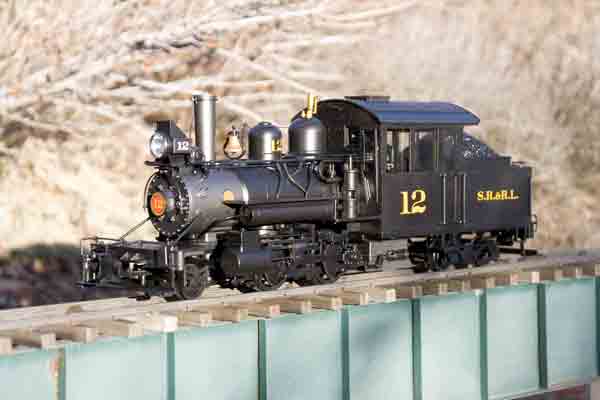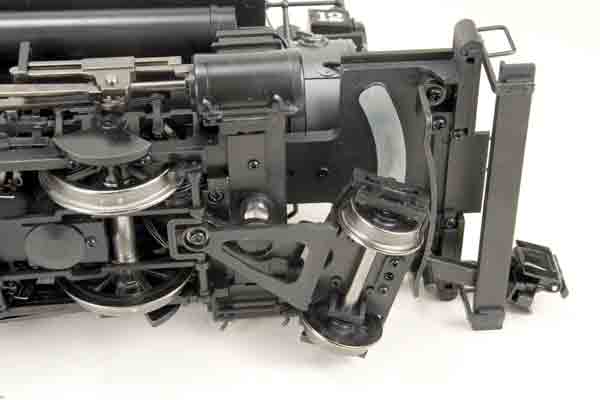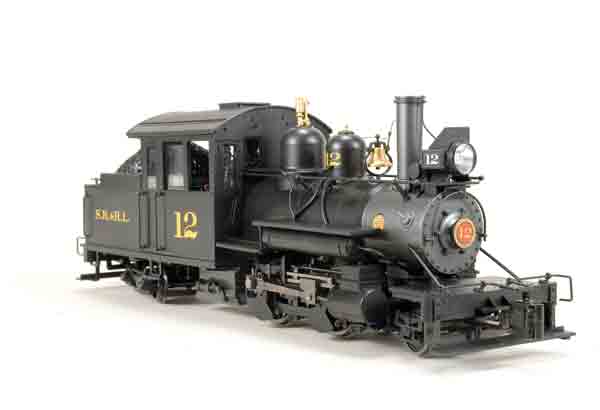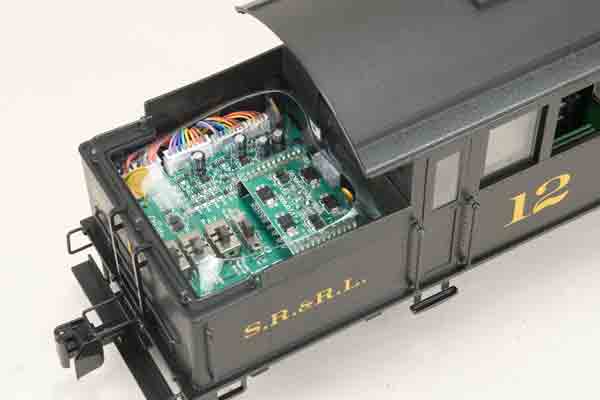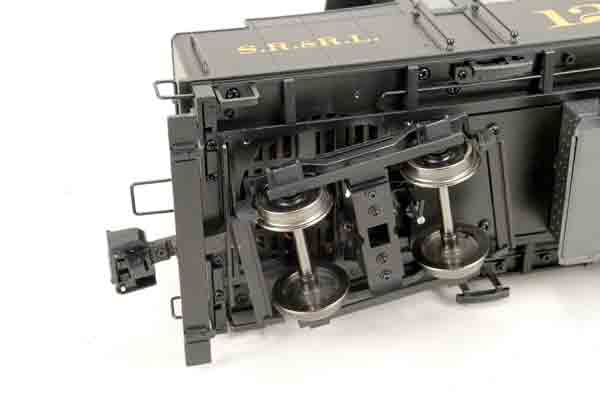Vital statistics
1:20.3 scale, gauge-1 Forney 2-4-4T
Bachmann Industries
1400 E. Erie Ave.
Philadelphia PA 19124
Price: $1,150
Web site: www.bachmanntrains.com
1:20.3-scale model of a Sandy River Forney; available lettered for SR&RL or unlettered; available with inside or outside frames, wood cab or steel cab; plug-and-play electronics for DC, DCC, and R/C; flywheel motor; all-wheel electrical pickup; detailed cab interiors, including opening doors, sliding windows, and backhead detail; directional, full-strength lighting; glowing firebox and ashpan (load compensated); sound-system ready; diecast detail parts; instruction manual and parts diagrams included. Dimensions: Length, 17¼”; width, 4¼”; height, 6½”. In 1:20.3 scale, this works out to 29’2″ x 7’2″ x 11’0″, respectively. Weight, 7 lbs., 0 oz.
Pros: High fidelity to prototype; high level of detail; excellent finish; easily accessible electronics; power truck swivels and trailing truck slides side to side, or not-your choice; smooth running characteristics; dummy Stephenson-link motion included; metal frames, rods, and other motion parts; optional body-mounted couplers supplied; excellent owner’s manual and parts drawings
Cons: Engine crew wrong scale, left over from the 1980s; power truck still a little loose in “locked” position
Watch a video of this locomotive in action!
Bachmann’s model is a fine offering. Its biggest departure from the prototype is that it is a three-foot-gauge engine, not a two footer, so that it will run on gauge-1 track. The engine looks great. It’s loaded with correct detail, is well proportioned, and has excellent paint and graphics. Our review sample is painted and lettered for SR&RL Nº 12. There appears to have been no Nº 12 on the Sandy River. Their 2-4-4 Forneys were numbered 8, 9, and 10. All had steel cabs, as does our review sample. Bachmann also offers a wood-cab version, as well as inside- or outside-framed versions (ours has outside frames).
The engine is provided with an excellent owner’s manual. It describes, in several pages and many pictures, all of the places on the engine requiring lubrication, followed by set-up instructions and an in-depth discussion of the engine’s extensive electronics. Also accompanying this model are several sheets of exploded drawings that show the assembly of every part of the locomotive. Additionally, there is a wiring diagram and basic disassembly instructions.
Bachmann has supplied their same old 1:22.5-scale engineer and fireman. While I’m sure these guys have a sterling work ethic, they just don’t look right in the cab of a locomotive of this quality. You may want to lay them off and hire more appropriate replacements. Also included is Bachmann’s usual bag of plastic detail parts. The engine would not suffer in the slightest if these were omitted.
One of my pet peeves with past Forney models by various makers is that they are not true Forneys. A Forney has a rigid frame under the boiler. Previous models were supplied with pivoting power trucks to get them around unprototypically tight curves. Bachmann’s current offering also has a pivoting power truck, with one major difference. If you are a stickler for prototypical operation, the power truck can be locked in its proper position with a single screw between the cylinders. When in the locked position, the truck still wiggles a little. This is not generally noticeable in operation and is a huge improvement over pivoting-truck Forneys. Likewise, the rear truck, in addition to swiveling on its kingpin, is equipped with a body-mounted track that allows it to slide laterally about an inch and a half, again for negotiating toylike curves. However, it, too, can be locked in the center position with a simple pin mounted on the truck. It will then slide laterally roughly a quarter of an inch. Thus you have the option of configuring the engine prototypically, should you so desire.
All wheels are metal and all provide electrical pickup. There are a number of other metal parts, including the frames, rods, counterweights, dummy Stephenson’s gear inside the frames, and other details. The equalizing levers are free to move (a nice touch) even though the chassis is not actually equalized.
Out of the box, the engine is equipped with metal knuckle couplers. The front coupler is mounted to a long arm attached to the leading truck. This gives it great swing for tight curves. The rear coupler, also attached to a long arm, comes with a spring arrangement to keep it centered and an interesting sliding arrangement that more or less maintains the distance it protrudes from the rear of the engine. Both of these couplers stick out too far but are good for tight-radius operation. Bachmann has also provided a set of body-mounted couplers for more fastidious modelers. Dummy lift bars are supplied. It might be possible to make them work on the body-mounted couplers.
This engine is loaded with lots of great features in addition to those already mentioned. All cab doors open, windows slide, and the ashpan doors open. There’s a glow inside the ashpan and the firebox, and the roof hatch opens. A cab light and a headlight are provided, but no backup light, as per the prototype.
Electronics are housed in the bunker and are as easily accessed as anyone could wish-simply lift off the dummy coal load. A switch behind the smokebox door lets you choose DC or DCC operation, or “off.” All other switches are on the circuit board in the bunker. These include lights (DC or DCC), power pickup (track or battery), polarity (NMRA or large-scale standard), and motor (off/on).
Atop the main circuit board is a “dummy” DC board. If you’re running straight track power from a standard DC power source, you needn’t do anything. If you want to install an aftermarket plug-and-play system, this dummy board easily lifts out and is replaced by the board supplied with your DCC system. If your DCC system is not plug-and-play, Bachmann has supplied a plug-in board that can then be wired to your DCC system using the connection diagram supplied.
For modelers wishing to install aftermarket sound systems, the engine is equipped with optical sensors to provide the correct number of chuffs per revolution of the drivers (four), as well as a switch for those who would prefer an incorrect number of chuffs (they can have two, instead). To install your sound system, you must remove the circuit board and install a 3″ speaker beneath it. This is all covered in the manual.
Bachmann has included an electronic feature that I’ve never seen before. A full-size steam locomotive, fresh from the shop, will have four, evenly spaced exhaust beats of equal volume. An engine that has been out on the road for some time, working hard, is apt to have valves in need of adjustment. This will result in uneven exhaust beats, often of different volumes. Bachmann has come up with a system of altering the individual chuff sounds that is directly analogous to tampering with a steam engine’s valve timing. The optical sensors reside in the valve chests. To adjust them, you remove the cover of each chest and carefully reposition the chuff-activation pin. This is pretty cool.
I tested the engine on regular DC track power using a 24V, 10-amp power pack. The engine runs smoothly and relatively quietly. The motor’s flywheel contributes to this smoothness. The flywheel effect is particularly noticeable when trying to stop quickly at higher speeds, as the engine has a tendency to coast a little. The headlight is directional, coming on only when the engine is running forward. The lights are supposed to come on at full intensity before the engine begins to move. In fact, the headlight does come on before the engine moves and it is pretty bright. However, it brightens noticeably when more power is applied.
Control throughout the engine’s range is excellent. It just creeps along at around 2V. At 24V, the speed is higher than what’s prototypical (though, from old film footage that I’ve seen, the Sandy River liked to run fast). From slowest to fastest, the speed range was easily controllable and running at a prototypical speed will present no problem.
This is a fine model of an interesting prototype, incorporating lots of great features. Forney locomotives were used in many parts of the world and in many situations so, chances are, one would fit in well on your railroad.





